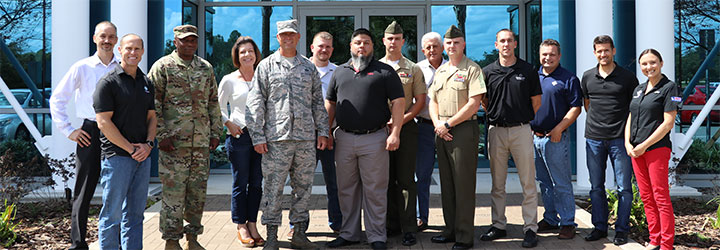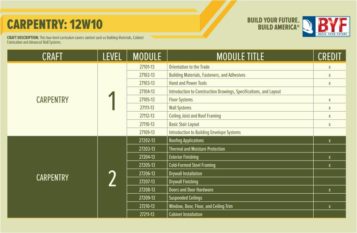
NCCER initiative expands resources for returning military transitioning into construction careers
NCCER recently celebrated the one year anniversary of its Hard Hat Heroes credentialing portal on Veterans Day. NCCER salutes its veterans by providing resources to help create a seamless transition into the construction workforce. The Build Your Future military initiative, Hard Hat Heroes, provides a way for veterans to receive NCCER credentials for the skills and training they received while in the military.
Hard Hat Heroes gained momentum in 2017 by creating a military advisory council consisting of veterans and industry representatives whose focus is on recruiting, training and retaining military service members in the construction industry. The ultimate goal of this council is to recruit veterans into the construction industry and to help ensure they have rewarding and sustainable careers through the use of resources and support of NCCER and its BYF Hard Hat Heroes initiative.
In addition, the number of alignments provided in the portal grew from 10 to 70 as a result of the collaborative efforts from the military advisory council, Army, Air Force, Navy and Marine Corps representatives. The alignments now available are 19 Army MOS codes, 36 Seabee Rates, 12 Air Force AFSCs and three Marine Corps MOS codes. Hard Hat Heroes has also released rank-based alignments for the four branches where service members are eligible to receive NCCER’s leadership credentials for the training they obtained while serving. The extensive expansion will continue as more alignments are scheduled to be released early 2018.
It is the commitment of those involved in this effort that has made it possible. NCCER recognizes the members of the military council, Darrin Amick of Bechtel, John Boerstler of NextOp, Jacob Guzman of KBR, Shane Hair of Day and Zimmermann, Chris Newton of Cajun Industries and David Theriot of Performance Contractors, for their hard work and dedication, along with special thanks to the Army, Navy, Air Force and Marines representatives for their participation.
During a recent survey of construction superintendents, 91.5 percent of the respondents said they feel there is a skilled labor shortage. With that in mind, Construction Superintendent reached out to NCCER to find out more about BYF and the Hard Hat Heroes initiative.
(Q) Provide a little background on how Hard Hat Heroes came to fruition through NCCER and BYF.
In 2012, the president created the Department of Defense Military Credentialing and Licensing Task Force, charged with 1) identifying military specialties that readily transfer to high-demand jobs, 2) working with civilian credentialing and licensing associations to address gaps between military training programs and credentialing and licensing requirements and 3) providing service members with greater access to necessary certification and licensing exams.
In response, a group of contractors, owners and stakeholders was established to connect returning military personnel with rewarding careers in the construction industry through NCCER’s Build Your Future initiative.
(Q) What type of credentials does NCCER provide for veterans? What are the advantages of these credentials?
BYF developed an industry crosswalk that aligned construction careers with Military Occupational Skill codes. Using the crosswalk, job seekers and employers could discover how various careers in the military match up with NCCER craft training. They could also look up projected job growth and wage information in various construction crafts. Wanting to spread the word to transitioning military, BYF worked with military veterans that were employed in the construction industry and actively recruiting service members to begin attending career fairs on military bases across the U.S.
On Feb. 12, 2013, at the first Veterans’ Employment in Construction Symposium, hosted by the U.S. Department of Labor and Joining Forces, First Lady Michelle Obama and U.S. Secretary of Labor Thomas E. Perez announced that a coalition of construction employers and associations had collectively pledged to hire more than 100,000 veterans over the next five years.
In addition, BYF released a Hire Military video as part of the Rethink Careers in Construction video series, to articulate to employers the broad range of characteristics that make military men and women attractive candidates for employment in their organizations.
In 2014, BYF expanded the military initiative and named it the Hard Hat Heroes initiative. Marketing collateral was created, more videos were added and, based on the overwhelming response from the construction industry, the team knew it had to create more granular crosswalks. The driving force was that military members and human resources managers needed its crosswalks to be expanded to the knowledge and competency level. At the same time, NCCER wanted to be able to provide credit to transitioning military and veterans for the training they received while in the military.
(Q) Talk a little about how Hard Hat Heroes provides a way for veterans to receive NCCER credentials. Define “alignments.”
In order to keep the integrity of NCCER’s credentials and provide appropriate credit to military, the organization needed to ensure it only gave credit for training that was comparable to the training provided by NCCER. So industry subject matter experts and military trainers reviewed the objectives and competencies for each training module and compared them to the objectives and competencies of the military training in each MOS code. Alignments are documentation in a chart format that shows where training matches and where there is a need for upgraded training to get the veterans to full credentials. In other words, alignments are the result of collaborative efforts to match up NCCER training and credentials with the military’s.
(Q) What types of resources and support does the BYF Hard Hat Heroes provide to veterans working in the industry?
More than 200,000 highly trained service members separate from the military each year. Of these 200,000 transitioning service members, over 60,000 will leave with skills directly related to construction. Considering the workforce shortage and the skills veterans possess from existing training, the Hard Hat Heroes credentialing portal allows the industry to fill these vacant positions with skilled individuals who have already shown an interest in construction. As the usage of the portal expands and full military units begin to submit for credentials, Hard Hat Heroes will be able to provide even more specific forecasts of not only the number of soldiers separating from the service who are interested in construction, but the specific crafts they are qualified to fill.
Along with the alignments and credentials provided by the initiative, Hard Hat Heroes works directly with NextOp, a Houston, Texas-based veterans’ advocacy group run by veterans, to provide career counseling and assistance with job placement.
(Q) What is the superintendent’s role with Hard Hat Heroes?
Hard Hat Heroes recognizes the leadership skills that military training provides and has aligned the higher ranking military specialty codes with NCCER’s Project Management and Project Superintendent training. Individuals receiving these credentials can and have been placed in supervisory roles because of the training they received while in the military. In addition, superintendents and HR representatives can use the alignments to place service members at the correct skill level on the job.
(Q) How many superintendents are involved?
The Military Advisory Council consists of veterans who work in the industry. One of the council members is a superintendent for an industrial construction company and provides insight from a superintendent’s perspective (placement, skill level, etc.).
(Q) How does the military advisory council go about recruiting, training and retaining military service members in the construction industry?
Another aspect to all of this is the recruitment factor. By providing a portal in which service members can view how their skills fit into an industry and providing industry-recognized credentials free of charge and without a lengthy testing process, the construction industry becomes more appealing and an industry of choice.
From an employer’s viewpoint, this portal can be used to outline the NCCER training a service member or veteran needs to be fully competent in their given craft areas. An employer can use this chart as a skills gap analysis for NCCER training competencies. If an X appears next to a module objective, then the service member is considered trained in that area and eligible to receive the module credit. However, if an X does not appear next to the module objective, then the employer knows the exact training required for the craft level completion. With this tool, an employer can continue training where the military left off and know exactly where to place that service member on a job based on their MOS code. It can also be used as a retention tool to show the service member a clear and easy way to understand the pathway to success.
The easy-to-read alignments help employers quickly understand and recognize skills that service members already possess in both craft and supervisory areas. With such a detailed training plan, the recruited individuals can feel confident that their training will be focused and their strengths recognized. These plans allow veterans to be placed into positions they are suited for, help them move along their career pathway faster and provide opportunities to be fast tracked into supervisory positions.
For those service members exiting without construction-related skills, Hard Hat Heroes provides access to NCCER’s online Core Curriculum to begin knowledge-based learning, along with information on how to continue training or testing on NCCER’s “Find a Training Center” webpage. All service members are then connected to Hard Hat Heroes’ Military Friendly Employers at byf.org/military, as well as other hiring agencies through NextOp’s placement efforts.
For more info, visit veterans.byf.org.




 Join our thriving community of 70,000+ superintendents and trade professionals on LinkedIn!
Join our thriving community of 70,000+ superintendents and trade professionals on LinkedIn! Search our job board for your next opportunity, or post an opening within your company.
Search our job board for your next opportunity, or post an opening within your company. Subscribe to our monthly
Construction Superintendent eNewsletter and stay current.
Subscribe to our monthly
Construction Superintendent eNewsletter and stay current.